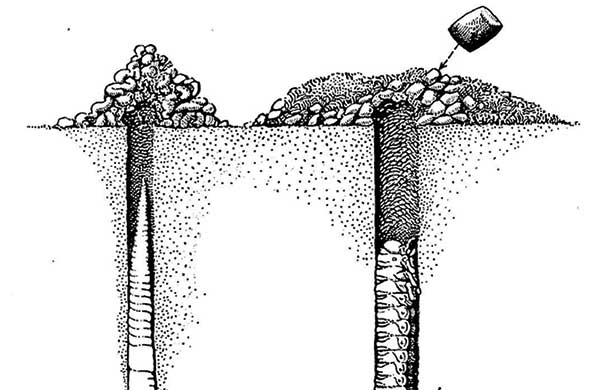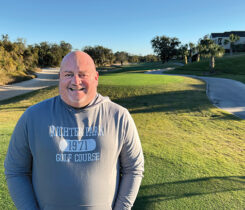Off the Record: Early golf course entomology

Burrows and castings of earthworm (a) and Southern Green June Beetle (b). Note the difference in the size of the burrows and the form of the castings (from The USGA Bulletin of the Green Section, April 22, 1921). (Photo: USGA Green Section)
I like to look back each month on the history of the USGA Green Section. My first step is to go to the Turfgrass Information File at Michigan State University. My search always reveals something about the pioneers of modern turfgrass science. Insects and articles before 1942 were the themes for this search.
The Green Section published more than 100 articles concerning insect problems on golf courses before 1942. Many answered questions from the readers on how birds visited courses to find insects. Earthworms and how to deal with castings also were popular topics.
The first articles were by W.R. Walton, an entomologist with the U.S. Department of Agriculture. The Bulletin of the USGA Green Section published three of his writings in 1921, including an April story about southern June beetles and in September, an article on control of the May beetle. The control measures taken were a little scary, e.g., sodium cyanide or kerosine fusel-oil emulsion. I liked drawings depicting the burrows and castings for earthworms and southern June beetle (Figure 1).
White grubs and earthworms were the primary insects discussed during the first year of the Green Section. However, Walton also wrote about the changa, or West Indian mole cricket, in the June 1921 issue. In 1929, he published an article on cutworms on golf greens, while W.B. Noble penned an article about sod webworms and their control in 1932.
In October 1921, B.R. Leach, another USDA entomologist, had an article about the Japanese beetle. At that time, this new beetle was only found on golf courses in New Jersey and Pennsylvania. He questioned how much of a nuisance this insect would become on golf courses. He described the insect’s damage and stated that it would not be easy to control.
By 1926, after four years of research, Leach recommended lead arsenate as a control measure. The application rate of 3.5 pounds per 100 square feet is a bit staggering compared to today’s insecticides. He noted extreme care is required when applying this poison.
In the 1930s, there were some lapses in The Bulletin of the USGA Green Section. Nothing was distributed in 1934, 1935 and 1937. The rest of the years in that decade had a bulletin for just a few months of the year.
In 1940, the Green Section changed its primary publication to Turf Culture for February and November. From May through October of that year, Timely Turf Topics also was published.
In the November 1940 issue, R.T. White summarized progress with “milky white diseases of Japanese beetle larvae.” In 1933, an organism was responsible for reducing larvae populations at the Moorestown, N.J., laboratory. In 1935, they discovered spore-forming bacteria were responsible for the grub disease. The USDA coordinated a program to help colonize the milky spores throughout New Jersey, Maryland, New York and Connecticut.
It is interesting to read about the early descriptions of the insect pests we deal with today on golf courses. The USGA Green Section depended heavily on USDA entomologists’ cooperation with members of several well-known golf courses. We are very fortunate to have dedicated entomologists at our land grant universities today.












